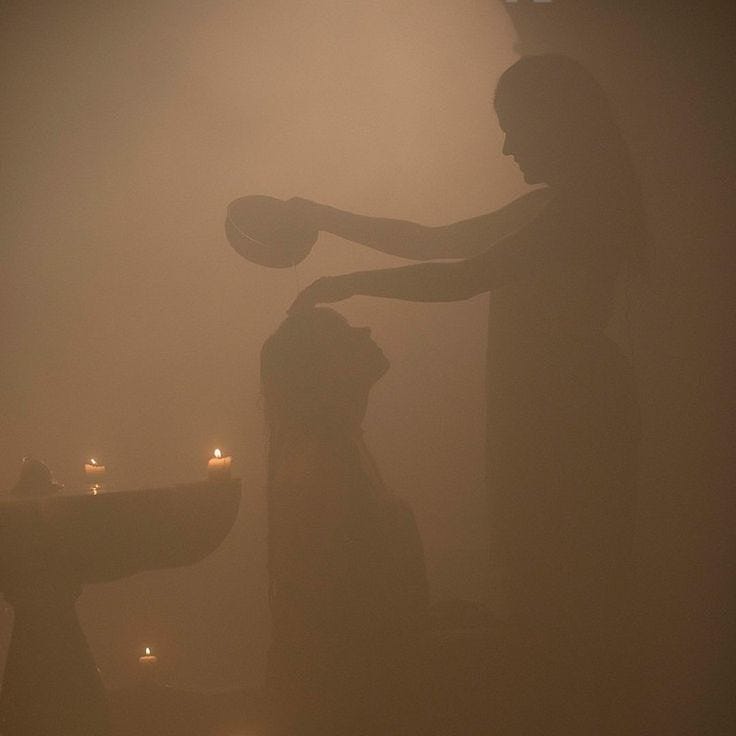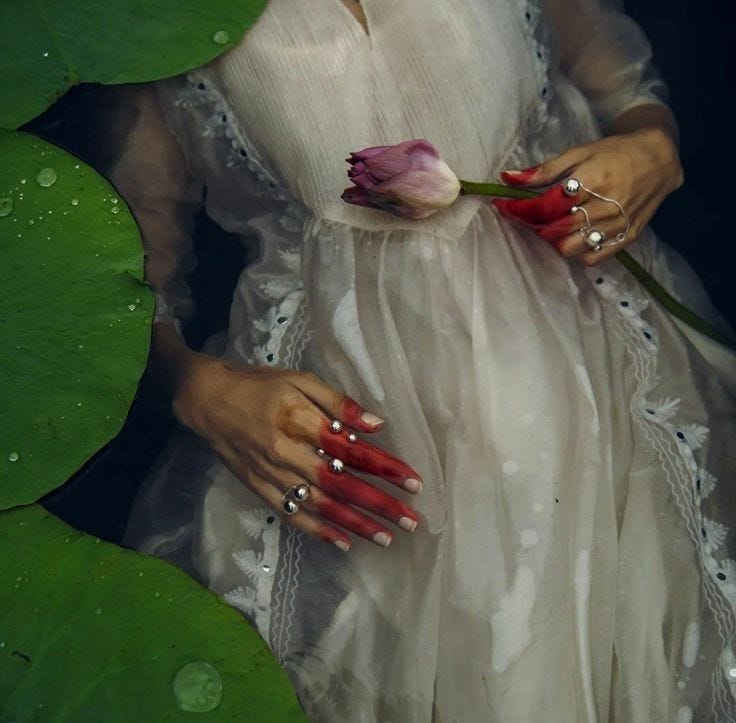
I reach for my soft silver & pearl earrings not because I have somewhere to be, but because I want to remember who I am. Not the self that answers emails, that smiles politely in passing, that folds laundry while thinking of five other things. I mean the deeper self; the one who moves slowly, who lingers at the mirror out of reverence. The one who understands that beauty is not applied, but summoned.
Adornment, when done in devotion, is spellwork.
Before Mirrors, There Were Rituals
There is a moment, often unnoticed, when a woman stands before the mirror.
A brush lifted to her cheek. The gentle clasp of a necklace.
The folding of soft fabric across her shoulders.
These are rituals. Acts of remembrance.
Threads that tether her back to herself.
To adorn oneself is to remember. It is to reach across time and touch something older than language. Before mirrors, before mass production, before beauty was distilled into trends and sold back to us through screens, women adorned themselves by instinct. They dipped fingers into handmade pigment. They wrapped themselves in bark cloth or indigo-dyed cotton. They pierced, painted, braided, wrapped. They did it not to be seen but because they saw themselves as part of the sacred. Beauty was inhabited, not pursued.
India: The Embodied Temple of Ritual Beauty
In ancient India, the act of adornment was invocation. A woman’s body was seen not as separate from spirit, but as its most immediate expression. To dress, to anoint, to decorate, were not embellishments. They were prayers made flesh.
She began at the center of her forehead, the ajna chakra. Just between her brows, where intuition lives and insight awakens, she pressed the bindi. Sometimes red, sometimes sandalwood paste, sometimes black to ward off the evil eye. But always intentional. A signal to the unseen realms: I see. I know. I carry wisdom.
Kajal was drawn not only to darken the eyes, but to sharpen inner vision. Ground from castor or camphor, it cooled the eyes and protected against malevolent forces. The lines around her gaze became a shield and an invitation.
She parted her hair with vermilion, sindoor, a thin red trail from brow to crown. It shimmered with the memory of Shakti, the feminine force of the universe. In many traditions, this was not simply a sign of marital status, but also was a conduit of life force, a symbol of active creative energy alive within her spine.
Around her neck, mangalsutra. On her wrists, glass bangles that sang her presence in delicate chimes. On her feet, alta painted her soles crimson like the earth had kissed her before she walked.
Each layer of adornment was a transmission from the ancestors. Her gold nose ring was a signal of fertility and sacred sensuality. Her anklets were offerings to the ground she walked upon. The scent of jasmine in her braid was a bridge to the divine.
These rituals were performed in quiet rooms before small mirrors. Or not at all. Sometimes done only by feel. Sometimes by firelight. But always with intention.
Egypt: Talismanic Color and the Ritual of the Eye
In ancient Egypt, beauty was inseparable from spirituality. To paint one’s face was not merely to embellish it, but to consecrate it. Egyptian queens, priestesses, and even common women adorned themselves using pigments ground from precious stones like lapis lazuli, malachite, galena, and crushed carmine beetles.
The famous kohl-lined eyes weren’t just seductive. They were spells. Applied in almond shapes, these lines were direct homages to the eye of Horus, which is a symbol of protection, healing, and divine sight. Women painted themselves into power, into sacred geometry. The blue and green eyeshadow tones were talismans against disease, against the desert sun, against evil spirits carried on the wind.
Even in death, the adornment continued. Tombs of queens like Nefertari were painted with delicate depictions of their adorned faces and bejeweled necks as sacred continuity. Beauty here was eternal. It carried one across the threshold.
West Africa: Scarification as Ancestral Scripture
In pre-colonial West African communities, the skin was not seen as something to be perfected or hidden. It was a living canvas etched with lineage, belonging, and becoming. Scarification was both art and language. Each line carved into the body carried meaning: a clan affiliation, a rite of passage, a triumph of endurance, a celebration of beauty.
In Yoruba culture, a girl might receive her marks during adolescence. In Dinka communities of Sudan, boys emerged from manhood rituals with foreheads ridged in striking patterns, which were proof of survival and spiritual maturation. These marks were not hidden. They were worn with pride, passed down like stories spoken through skin.
For women, the scars often traced beauty's edge. Curves of raised flesh along the collarbone or belly were symbols of fertility, sensuality, and strength. They marked a woman as adorned by her ancestors, shaped by more than what the eye could see.
To run your fingers along these patterns was to read a life. To trace the map of who someone had been, and what they had withstood.
Mexico: The Cloaked Divinity of Guadalupe
In 1531, on a hill called Tepeyac just outside of Mexico City, a Nahua man named Juan Diego encountered a woman who shimmered with light. She was not fair-skinned, not blonde-haired, not the Europe-born Virgin depicted in colonial churches. She was brown. Indigenous. Radiant.
The Virgin of Guadalupe wore a cloak of turquoise sky scattered with stars. Her dress, a deep rose, bore golden florals resembling sacred Mesoamerican symbols. She stood atop a crescent moon, her hands joined in prayer, surrounded by rays of sun, as an echo of the Aztec mother goddess Tonantzin.
To the people of Mexico, she was not just Mary. She was the bridge between worlds: colonizer and colonized, Christian and ancestral, flesh and spirit. Her garments spoke in cosmic language. The flowers on her gown mapped constellations. The sash around her waist was an indigenous symbol of pregnancy, which declared her a mother of both the divine and the earth.
The cloak itself became one of the most sacred objects in Latin America. Miraculous for its preservation, for its woven fabric of cactus fiber still intact after centuries.It was ordinary matter turned holy.
Guadalupe’s adornment was a statement: the sacred can appear in the skin and symbols of the marginalized. Her beauty was was sovereignty wrapped in stars.
Adornment is always more than it seems.
I think of my grandmother, who wore perfume even in her solitude. Her kadas clinked like wind chimes in prayer. Her sari pleats sharp as moonlight. She adorned herself to anchor. It was her way of saying, I am here. I am worthy of beauty, even in my quiet. She wore them even when alone. When sweeping. When making tea. Her sari was always pinned just so, her hair oiled and braided with precision. She did not do this because someone was watching. She did it because it was who she was. There was a dignity in the ritual. A remembrance of her own place in the order of things.
The world we live in now has turned adornment into performance. But beneath this superficial layer, there is still a pulse. A whisper. A desire to reconnect with the ritual of becoming. This is where the wild feminine lives. In the quiet choosing of earrings that remind you of your mother, the silk you wear to water the plants, the scent you dab at your wrists just before you sleep.
The Japanese art of kintsugi teaches us to mend broken pottery with gold. Not to hide the break, but to illuminate it. To honor the fracture as part of the form. Imagine if we adorned ourselves this way. If instead of hiding our tired eyes, we traced them in copper. If instead of concealing our stretch marks, we inked them with poetry. If we dressed our scars not to erase but to exalt.
The wild woman within does not adorn herself to be approved of. She dresses as ritual. She adorns as reclamation. Each piece she chooses says: I am here. I am whole. I carry memory, and longing, and laughter in the folds of my fabric. And I do not need to explain.
There is an ancient story from Sumer about the goddess Inanna. She descends into the underworld to visit her sister, Ereshkigal. At each of the seven gates, she is required to give up a piece of her adornment. Her crown, her jewels, her scepter, her robes. When she arrives, she is naked. Stripped. Unveiled. Her power is not in the gold she wore. It is in her willingness to descend. To meet the shadow. To stand in her truth without armor.
We too descend. Into heartbreak. Into illness. Into loss. The world takes things from us. Sometimes gently, sometimes all at once. But when we return to adornment not as camouflage, but as expression, we begin to reweave our own mythology.
To choose a pair of earrings that jingle when you move. To wrap your hair in cloth that reminds you of the stories your aunties told. To wear your grandmother’s ring on a finger now shaped by age or motherhood or both. This is how we say, "I remember who I am."
In my own practice, I have begun to reclaim the slow art of dressing. I light a candle. I play music that softens me. I choose fabric that breathes. I paint my lips to amplify. To echo something true. Some mornings, this practice lasts only five minutes. Other days, I lose time in it. I forget the rush. I forget the mirror. I enter something else entirely.
We are told that beauty is indulgent. That we should be practical. Efficient. But there is nothing efficient about wonder. There is nothing utilitarian about delight. To adorn yourself is to say, "I matter." It is to say, "This body, this breath, this hour—deserves beauty."
The wild feminine knows this. She lives in all of us, waiting. She is not afraid of color. She is not afraid of quiet. She paints her nails before tending the fire. She wears silk while feeding the baby. She braids her hair like a prayer. Adornment, in her world is essential. It is devotion.
Let this be your invitation. Not to consume more, but to choose differently. To see your jewelry not as accessory, but as memory. To see your clothes not as cover, but as expression. To dress as if you are meeting the divine. Because you are.
Adorn yourself like you are the altar. Because you are.
Let every clasp and smear and fold be a hymn. Let beauty be your devotion. Let your reflection be the sacred text you read before the world begins.
You are allowed to be seen. You are allowed to shine.
Because you are sacred. Because you are still here. Because you are worth adorning.
Is there a ritual or piece that brings you back to yourself? A scent, a fabric, a sound? I’d love to hear what adornment means to you.
💌 Reply here or leave a comment.









this reverberated in my whole body. thank you
Beautiful. Thank you for this. I journalled a similar sentiment last night. Tapping into this flow was a feeling that has been bubbling up for some time now, but what you share here is even more - a wisdom, a remembrance, an invitation. Thank you, thank you, thank you. I have been hearing this call to my soul. I am ready to show up again for myself in this way ♥️